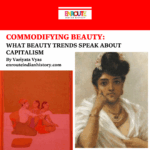
Reflecting on the headlines of 2020, we may recall the mention of the Pir Panjal range, located in the Western Himalayas. This mountainous expanse gained new light during the COVID-19 pandemic lockdown for its newfound visibility from Srinagar, as pollution levels reduced and the range emerged clearly on the horizon. However, amidst this natural spectacle, the region has also recently witnessed an escalation in militant and terror-related activities. Despite these contrasting developments, the Pir Panjal range holds within itself a mysterious trove of history—a collection of forgotten sculptures depicting horsemen, adding to its cultural and historical significance.

(credits – @waseem_andrabi on Twitter)
Part of the Lesser Himalayas, the Pir Panjal range shares etymological ties with the ancient Mahabharata-era kingdom of Panchala, which has been a subject of scholarly study. A deeper examination underscores an uninvestigated history. The warhorse sculptures of Pir Panjal, particularly those found in Ghora Gali near the village of Gool, in Ramban District, bear a remarkable resemblance in their cultural significance to the famed Terracotta Army of Xi’an, China. The Terracotta Army, consisting of thousands of life-sized figures buried with the first Emperor of China, has gained worldwide recognition for its archaeological importance and has been meticulously preserved and studied. In contrast, the equally fascinating horsemen statues of Pir Panjal have not received the same level of attention or care. Despite their potential historical and cultural value, these sculptures have been largely neglected by the Archaeological Survey of India (ASI).

(credits – travelthehimlayas.com)
The Ghora Gali
Ghora Gali, also known as “The Horse Pass,” is an alluring feature located in the Pir Panjal mountain range of Jammu and Kashmir, India. The term “Gali” translates to “street” in English, and in this context, it refers to ancient trade routes or passes through the mountains. The Pir Panjal range historically connected the Kashmir Valley with the rest of India via the Mughal Road, a significant trade and travel route during the Mughal era. These routes played a vital role in commerce and cultural exchange, linking the region with the great Greco-Roman civilizations and the flourishing Bactrian region of Central Asia. One of the most mysterious and fascinating aspects of Ghora Gali, which has ascribed it the peculiar name, is the collection of more than 200 sculptures of horsemen scattered across the landscape. This area has been described as an open-air museum where these sculptures, depicting mounted horsemen, stand about 1.5 meters tall and are spread over an area of 4-5 acres of inaccessible land in the woods of Gool village. Their exact origins and age remain unknown, adding to the allure and historical curiosity of the site. The sculptures exhibit stylistic elements that reflect Bactrian influences rather than Indian, evident in the dress of the horsemen and the design of the arms they carry. Even the figures of deities etched on the stone slabs bear little resemblance to contemporary Indian deities, with geometric figures further enhancing the site’s mystique.
In June 2017, a Russian-Indian archaeological team, including Russian historian Natalia V. Polosmak, conducted a detailed study of the sculptures in the Pir Panjal Range. Polosmak’s research notes describe an army of about 200 horsemen sculptures, arranged randomly across the landscape. The area is remote and uninhabited, accessible only via a trail built by the military. The sculptures’ presence in such an isolated location underscores the historical and cultural significance of the region.
Hephthalite Origins
These sculptures are notable for their detailed features, including artificial cranial deformities, large triangular noses, handlebar mustaches, and distinctive earrings. Such characteristics are consistent with a particular warrior character inhibiting people – the Hephthalites. The Hephthalites, also known as the White Huns, were a group of nomadic people playing a vital role in the history of Central Asia and South Asia. Originating from the steppes north of the Oxus River, they emerged as a powerful force in the 5th and 6th centuries CE. The Hepthalites carried warrior-like qualities and were known for their military prowess and skill in horseback warfare. The features of the horsemen statues are strikingly similar to those found on Hephthalite coins, linking the sculptures to Hephthalite rule during the 5th-7th centuries CE.

(credits – Science first hand journal )
Natalia V. Polosmak posits a theory linking the origins of certain Indian ethnic groups to the influence of the Hepthalites (White Huns) during their rule in Northern India from the 5th to 7th centuries CE. She identifies the Rajputs, Gurjars, and Jats as ethnicities that may have integrated with the local ecology and society under Hepthalite influence, leading to their prosperity and cultural development. Polosmak suggests that the Rajputs, known for their martial traditions, later influenced the emergence of the Dogra ethnic group in regions like Jammu, Punjab, Himachal Pradesh, and northeastern Pakistan.
Warriors or Ritual Specimen
A closer look at the statues reveals the nature of their placements to not be random rather they have been placed near cascading basins which may have been intended for ritual ablutions underscoring their connection to Hindu traditions. Decorative motifs such as lotus-shaped rosettes on the flagstones further enhance their ceremonial significance.

(credits – Prashant Mathawan.)
The mythological significance of horses is not hidden from us. We know of, the Asvamedha sacrifice, recounted in the Ramayan epic. Rajput literature describes pre-battle rituals where horses were adorned and led to a water reservoir for watering and washing after which they were worshipped by warriors, often alongside their mothers or wives, underscoring their sacred status in warfare. With this, we may also note that there is a presence of female figurines on the horse statues too. The women are depicted on the horses as singles, in pairs, and even in groups. They are identified by the presence of long skirts ornamented with a geometrical pattern. Some of the figurines also have babies sculpted with them.
However, we cannot attribute the statues exclusively to Hinduism, as the Hephthalites show a diverse religious influence that includes Buddhism, Zoroastrianism, early Christian influences, and even pagan practices. Therefore, the religious symbols on the statues still possess a certain amount of ambiguity.
The Local Perception and Governmental Neglect
Relating to ancient mythological stories the horsemen sculptures are believed by locals to have been created by the Pandavas during their visit to the region a millennia ago. Some speculate that these sculptures might have served as traffic signs from the Mahabharata period. However, due to the lack of protective measures, many sculptures have been damaged or repurposed by locals, including being used as washstones. Besides this, extreme weather conditions also pose a threat to these statues. Despite neglect from the Archaeological Survey of India (ASI), one of the sculptures is preserved at the Shri Pratap Singh Museum in Srinagar. The Directorate of Archives, Archaeology, and Museums, Jammu and Kashmir, declared this site protected in 1986. Nonetheless, the site remains largely forgotten, with many sculptures in disrepair due to exposure to the elements.
The Pir Panjal Range is a wonderful natural wonder with a diverse repository of flora and fauna alongside harboring a knowledgable track and mysterious cultural heritage. Indeed, Natalia Polosmak and her team have highlighted that the descendants of the creators of these statues still reside in the area, often unaware of their historical significance. These sculptures, which now sometimes interfere with farming activities, represent a riveting chapter of Indian history that has remained largely unexplored and under-appreciated. Despite their proximity to these ancient artifacts, many locals regard them as mysterious remnants from an unknown past. This disconnect highlights a broader issue of historical preservation and a lack of ethnographic awareness and studies in the region posing as a disregard for the legacy of the people who created them.
References –
Times of India, 2020. Lockdown impact: Kashmir’s Pir Panjal range is now clearly visible from Srinagar. Available at: https://timesofindia.indiatimes.com/travel/kashmir/lockdown-impact-kashmirs-pir-panjal-range-is-now-clearly-visible-from-srinagar/ps75419367.cms
The Hindu, 2023. Anti-militancy operations focus on forested areas of the Pir Panjal Valley. Available at: https://www.thehindu.com/news/national/anti-militancy-operations-focus-on-forested-areas-of-the-pir-panjal-valley/article67604980.ece
POLOSMAK, N.V., 2018. Riders lost in the Himalayas. Science First Hand, (1), pp.28-47. Available at https://scfh.ru/en/papers/riders-lost-in-the-himalayas/
Academia.edu, 2018. The mysterious horsemen of the Pir Panjal. Available at: https://www.academia.edu/37121162/The_mysterious_horsemen_of_the_Pir_Panjal

















